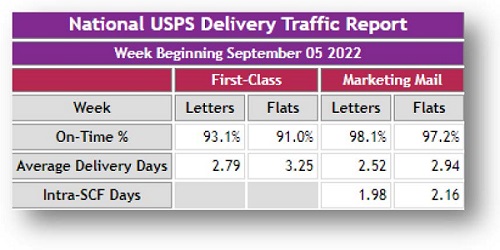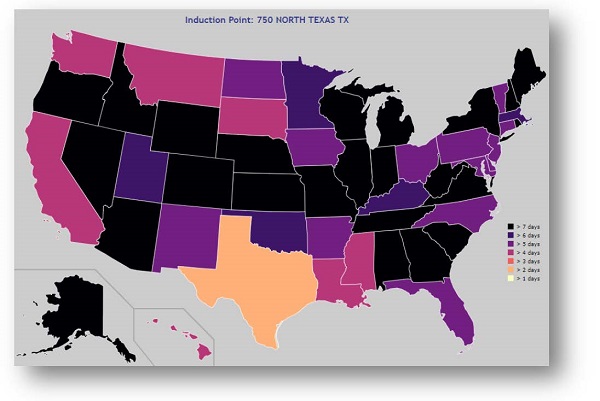SnailWorks compiles a ton of delivery analytics as a result of tracking millions of pieces of mail a day for our hundreds of clients. We use this compiled data to create the US Mail Traffic Report that we post every Monday on Linked In. That report, which is distributed to the world, is a great tool for spotting delivery trends, based on national and regional averages, but there is not enough there for a solid predictive analysis of a particular mailing. Beware of averages!
Here's our national report for the week of September 5:

First off, you can pretty well ignore the on-time percentage. Great for spotting trends and evaluating overall delivery health and keeps USPS honest – that’s the figure they share – but no real help in planning your mailing.
Average delivery days are more interesting. A couple of things to keep in mind. First, these are measurements of professionally prepared commercial mail. Your birthday card to Uncle Ernie is not reflected. Secondly, it is a measure from the induction of the mail into the USPS to delivery, not necessarily when it leaves your dock.
First-Class Mail is most often inducted at an origin post office. There is no postage incentive to transport to a destination facility and its delivery is kind of predictable, so it’s all usually just entered at the local post office. So, the Average Delivery Days stats are a somewhat useful guide for mail from random point A to random point B. Sure, a local letter will be delivered faster than one across the country, but if you have a nationwide First-Class mailing it should take on average the days shown.
Marketing Mail, which includes nonprofit, is entirely different. The vast majority of the Marketing Mail we track is not entered locally – it is trucked to the delivery SCF or NDC where it is inducted. There is a big incentive in both postage and delivery time. Remember that the figures we show here don’t start until the mail is received by USPS. So, if you take a nationwide Marketing Mail job to the local post office it will almost certainly take, on average, a lot longer than 2.52 or 2.94 days shown above.
If you are drop shipping into SCFs, the most important numbers for you are the Intra-SCF Days. Almost universally it takes about two days for Marketing Mail to be delivered from SCF induction to delivery within that SCF. That figure stays pretty consistent across facilities, when things are going well. Things don’t always go well. During a holiday rush, we have seen some facilities back up for days. So, keeping an eye on that average can be important. We also track the performance of individual facilities, but it is a bit much for Linked In. We will, though, note when there are trouble spots.
SnailWorks subscribers have access to more analytics that can be invaluable for mail planning. The analytics tools are accessible from the home page.

Probably the best tool we have is Average Delivery Days from Induction Point. With this report you can select your induction point and class of mail and see how long delivery has been taking to individual states or SCF areas. Here’s expected delivery times for Marketing Mail entered in North Texas, TX:

There are lots of options in this tool, and it is purely self-service. You can do this. (Plus your SnailWorks Project Manager can help.) If you need more detailed analytics, we have access to those as well, and can look many up for you.

Analytics are powerful and can be confusing. As with everything at SnailWorks, we help make them simple. Contact us to find our how you can access these tools.